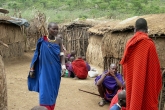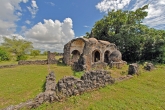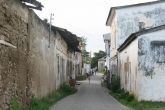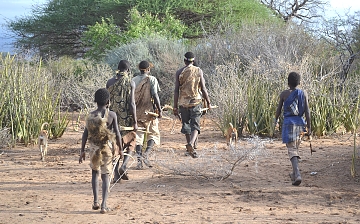The Hadzabe tribe - Cultural experience Tanzania 567
The Hadzabe tribe of Tanzania is the last true nomades of Africa. Evans Adventure can take you on an amazing adventure with the Hadzas. You will join the men as they hunt for their daily subsidance using traditional Bow and arrows, or join the women as they forrage for fruits and berries. This is not a show or a "tourist put on". This is the real deal. A true African cultural experience, not for the faint of heart.
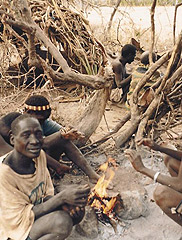
Hadzabe
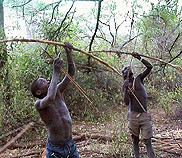
Hadzabe
There are four traditional areas of Hadza dry-season habitation: West of the southern end of Lake Eyasi, between Lake Eyasi and the Yaeda Valley swamp to the east, east of the Yaeda Valley in the Mbulu Highlands, and north of the valley around the town of Mang'ola. During the wet season the Hadza camp outside and between these areas, and readily travel between them during the dry season as well. Access to and from the western area is by crossing the southern end of the lake, which is the first part to dry up, or by following the escarpment of the Serengeti Plateau around the northern shore. The Yaeda Valley is easily crossed, and the areas on either side abut the hills south of Mang'ola.
The Hadza have traditionally foraged outside these areas, in the Yaeda Valley, on the slopes of Mount Oldeani north of Mang'ola, and up onto the Serengeti Plains. Such foraging is done for hunting, berry collecting, and for honey. Although hunting is illegal in the Serengeti, the Tanzanian authorities recognise that the Hadza are a special case and do not enforce the regulations with them, just as the Hadza are the only people in Tanzania not taxed locally or by the national government.
Hadza men usually forage individually, and during the course of day usually feed themselves while foraging, and also bring home some honey, fruit, or wild game when available. Women forage in larger parties, and usually bring home berries, baobab fruit, and tubers, depending on availability. Men and women also forage co-operatively for honey and fruit, and at least one adult male will usually accompany a group of foraging women. During the wet season, the diet is composed mostly of honey, some fruit,fdr tubers, and occasional meat.
The contribution of meat to the diet increases in the dry season, when game become concentrated around sources of water. During this time, men often hunt in pairs, and spend entire nights lying in wait by waterholes, hoping to shoot animals that approach for a night-time drink, with bows and arrows treated with poison. The poison is made of the branches of the shrub Adenium coetaneum.
The Hadza are highly skilled, selective, and opportunistic foragers, and adjust their diet according to season and circumstance. Depending on local availability, some groups might rely more heavily on tubers, others on berries, others on meat. This variability is the result of their opportunism and adjustment to prevailing conditions.

 German
German Spanish
Spanish





